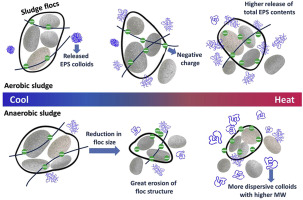Environmental Pollution ( IF 7.6 ) Pub Date : 2017-09-11 , DOI: 10.1016/j.envpol.2017.08.119 Long-Fei Wang , Chen Qian , Jian-Kai Jiang , Xiao-Dong Ye , Han-Qing Yu

|
Sludge dewatering is an important process in municipal wastewater treatment and critically influences the subsequent transportation and disposal. Thermal treatment coupled with other chemical processes has been widely used to improve sludge dewaterability. However, information about the response of sludge extracellular polymeric substances (EPS) to thermal treatment and its role in sludge dewatering is still limited. In this work, the effects of thermal treatment on anaerobic and aerobic sludges were investigated with an emphasis on the colloid properties of released EPS in sludge dewatering process. The results indicate that sludge dewaterability became deteriorated with the increased temperature in the range of 30–170 °C, which was ascribed to the disintegration of sludge flocs and change of EPS characteristics. Disintegrated sludge induced the release of the negatively charged EPS, resulting in the weakened bridging interaction and lower compactness. After thermal treatment, the EPS with a higher average molecular weight and stretched coil configuration retained more water. In addition, difference in dewaterability between anaerobic and aerobic sludges was found to be attributed to their different contents and structures of EPS components. These results provide an insight into thermal-dependent sludge dewatering process and are useful to facilitate water-sludge separation.
中文翻译:

污泥脱水过程中细胞外聚合物对热处理的响应
污泥脱水是城市污水处理中的重要过程,严重影响后续的运输和处置。热处理与其他化学工艺相结合已被广泛用于改善污泥的脱水性。但是,关于污泥细胞外聚合物(EPS)对热处理的反应及其在污泥脱水中的作用的信息仍然有限。在这项工作中,研究了热处理对厌氧和好氧污泥的影响,重点是污泥脱水过程中释放的EPS的胶体性质。结果表明,随着温度在30–170°C范围内的升高,污泥的脱水性变差,这归因于污泥絮凝物的分解和EPS特性的变化。分解的污泥导致带负电的EPS释放,导致桥接相互作用减弱和压实度降低。热处理后,具有较高平均分子量和拉伸线圈构型的EPS保留了更多的水。此外,发现厌氧污泥和好氧污泥之间的脱水性差异是由于它们的EPS成分含量和结构不同所致。这些结果提供了对与热有关的污泥脱水过程的认识,并有助于促进水污泥的分离。发现厌氧污泥和好氧污泥在脱水能力上的差异是由于它们的EPS成分含量和结构不同所致。这些结果提供了对与热有关的污泥脱水过程的认识,并有助于促进水污泥的分离。发现厌氧污泥和好氧污泥在脱水能力上的差异是由于它们的EPS成分含量和结构不同所致。这些结果提供了对与热有关的污泥脱水过程的认识,并有助于促进水污泥的分离。











































 京公网安备 11010802027423号
京公网安备 11010802027423号